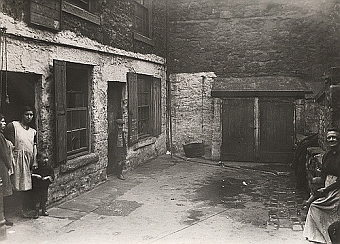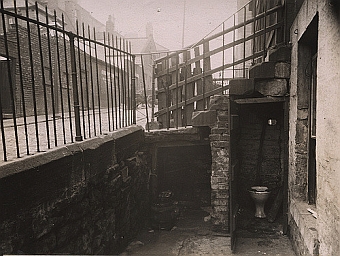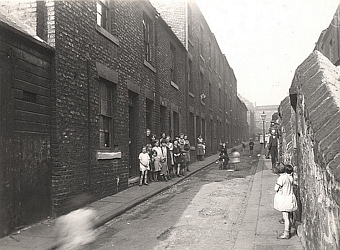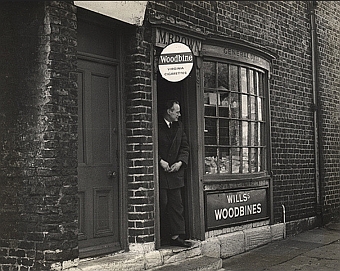Henry Stephenson - a young criminal who became a pillar of the community.
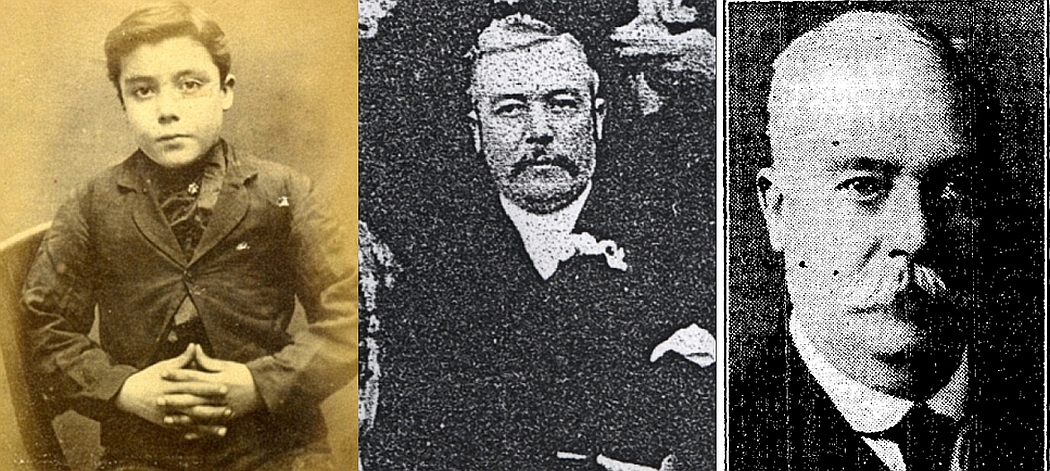 Mr Henry Stephenson (1859 - 1932)
Mr Henry Stephenson (1859 - 1932)
"Fagin's Children"
The above left mugshot of Henry Stephenson appeared in the Daily Mail in an article about Victorian children who were sent to prison for theft. As usual there was hardly any research involved in the story. What became of these young villains? That was an exercise left for the reader.
Very short children
Henry Stephenson and the other children were very short for their ages compared to children today. Twelve year old Henry was only 4'5" which is about the height of an average eight year old today. My eight year old son is 4'6" and my eleven year old son is 5'1" and they are not particularly tall. Despite Henry's shortness he doesn't look ill or malnourished. One of the boys in the mugshots was only 4'2" at 15. Perhaps the magistrates felt sorry him. Unlike the others, who were mainly younger then him, he was spared going to prison.
The Crime
HOUSEBREAKING AT NEWCASTLE - TWO BOYS APPREHENDED
[Morpeth Herald - Saturday 12 October 1872]At the Newcastle Police Court on Monday, before Mr. Ald. Nicholl and Mr. Ald. Wilson, Richard Clement Fisher (13) and Henry Leonard Stephenson (12), were charged with housebreaking and theft. Chief Constable Nicholls said the boys were charged with breaking into the house of Mr. Green, in Lawton Street, and stealing various articles therefrom. During the last month or six weeks 8 or 10 unoccupied houses had been broken into and their contents ransacked and things taken away. He had every reason to believe that he should be able to prove satisfactorily to the Bench that the majority, if not all of theses houses had been broken into and entered by the prisoners. He was not then prepared to go into the numerous cases and proposed to offer only evidence sufficient to justify him in asking for a remand.
John Thomas Green: We left for Tynemouth on the 18th of last month, and returned a fortnight to day. I found that the house had been broken into by the pantry window, through a zinc pane, and that the bolt of the kitchen door had been drawn, and access gained to the house. I found all the window shades down; they were spread on the floor, as if to deaden the sound of feet. I missed a violin case - the violin was left, a thermometer, and boy's cash-box. [Violin case produced and identified.] Witness thought the thermometer produced was his, but there were many others like it, and it had no mark by which he could identify it.
Detective Anderson deposed: During the last three weeks I have been making inquiries with reference to the housebreaking at the west end of the town. On Friday afternoon, I saw the two prisoners standing in Summerhill Street. I went up to Fisher and asked his name. About half an hour afterwards, I took Fisher to his mother's house in Summerhill Street, and in the presence of his mother told him that I was a detective officer, and that I suspected that he had broken into a number of houses and stolen various articles. I asked him If he had any keys. He replied "Yes, I have a small bunch of keys in my pocket." I asked his mother if he had a box, and she said he had not. I said I suspected that he had a box, and she left the room and returned with a small wooden box. As she came along the passage I heard something fall as if from the box ; and on going to the passage in company with the prisoner and his mother, I found a bunch of keys. I went into a back room and found the violin case.
About 7 o'clock on Friday night I went to Elswick East Terrace, where Stephenson resides with his grandmother. I told him I suspected him of breaking into several houses in company with Fisher. He said he had not done so. I searched the house, but did not find anything. I went back some time after and found the thermometer produced hanging in the parlour. I took Stephenson to the Laurel Street Police Station, and he then said in reference to the thermometer, "Oh! it was got along with the violin case". The prisoner was remanded for a week.
Come on boys pelt him!
After arriving in Ashburton, New Zealand in 1878, when he was about 18, Henry worked for Alfred Harrison, an auctioneer. Harrison was an influential person in Ashburton. He became mayor of the town and like Henry and Henry's father he was a Freemason. After 20 years working with Harrison Henry took over the business and Harrison concerned himself with his other commercial interests. However, it wasn't all plain sailing for Henry. Judging by the following 1888 press report he had trouble with the neighbours :

Ashburton Guardian 29 March 1888
Henry gets a taste of his own medicine
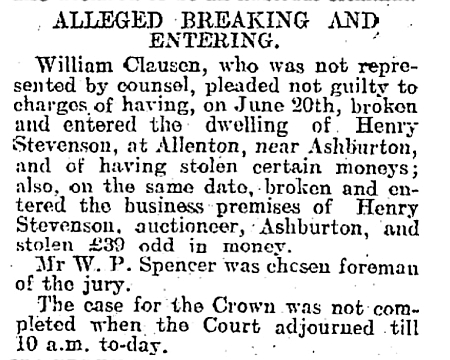
Ashburton Guardian 7 November 1918
William Neculai Clausen was a 50 year old Dane. One newspaper report described him as a "socialist advocate" adding that he was well known for his "soap box" oratory and for playing a prominent part in strikes. Apart from many burglaries in the Ashburton area one of his crimes involved organising a collection for an injured fellow workman and then using the money for gambling. It seems that Clausen was the kind of socialist whose views on property redistribution are mainly self-focused. While he was on remand for the above crimes he escaped and the newspapers warned that he was a dangerous criminal. When he was recaptured a year later he got a five year sentence. He escaped again and then had another year added to his sentence.
Bleak House
Henry lived in Bleak House, Allenton, Ashburton. According to one site "Bleak House was so named by Henry Stephenson who commissioned this house to be built in 1908. He was an avid fan of Charles Dickens, whose novel Bleak House inspired the design." The site also mentioned that Bleak House had been transported from Allenton to Waitakere, Auckland. The above quote was accompanied by the following picture :
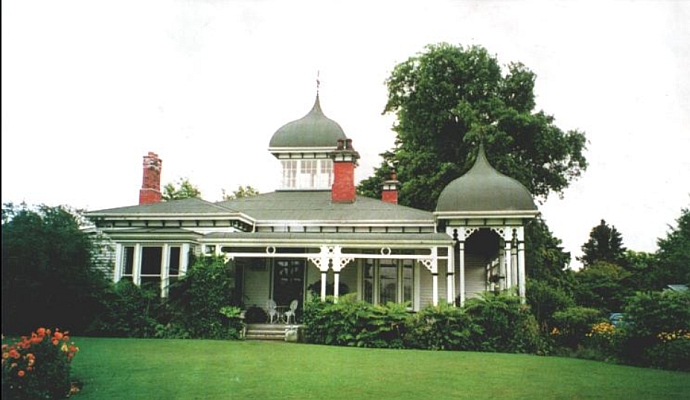
Bleak House, Allenton, Ashburton
I've not been able to find any other pictures of that beautiful house or any corroborating information, but the Stephensons were intelligent and artistic people so I suppose it is the kind of house that Henry would design.
Henry Stephenson's Hospitality at Bleak House

Ashburton Guardian 5 December 1921
The next few years were difficult for Henry. His wife died in 1922 aged 63 and his eldest son Henry Permain Stephenson died in 1924 aged 42.
Henry Stephenson died in 1932 aged 73
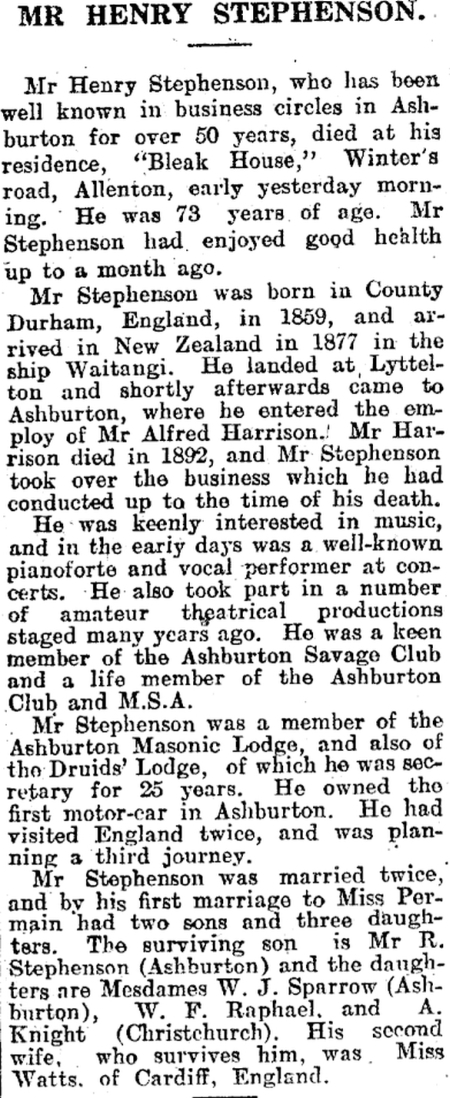
Ashburton Guardian 24 December 1932
Like most newspaper reports the above obituary contained a lot of errors. Harrison died in 1901 and he handed over the auction business to Henry four years before his death. Harrison's wife was a Miss Watt and Henry's second wife was Watts from "Cardiff, England"! This might be the same person.
Henry did well for himself after a very difficult start in life. Some of that success is due to the support he would have got from people like Alfred Harrison but most of it can only be put down to his intelligence and character. In the photos at the top of the page showing him in childhood, middle age and old age he has the same confident and honest look in his eyes. The local paper shows that over the years he played a prominent role in collections for charity and he would have been very well respected by the people of the town. I wonder if they, or his children, ever found out that he was sent to jail as a child.
An intelligent face
Henry's mugshot stood out from the others. There was something about the boy's intelligent looking face that made me think that if he lived then he would go far. Well, he did go far - all the way to New Zealand. The obvious response to his later success in life is to point to the "cycles of deprivation" theory, which claims that emigration is usually the only way for those brought up in criminal families to avoid the life style of their parents. But Henry came from a respectable, albeit downwardly mobile, family.
Elswick East Terrace
At the time of his crime Henry was living with his grandmother at 118 Elswick East Terrace, Newcastle. His mother had died when he was about three and his father was working away from home. Although she was now living in a poor working class street, the grandmother, Elizabeth Stephenson, had probably lived in some style when she lived in India where her husband John Stephenson was a chemist who had been Superintendent of Factories for the East India Company in Bihar. John Stephenson wrote articles for the Journal of the Asiatic Society of Bengal, e.g. a "Treatise on the Manufacture of Saltpetre" 1835. Elizabeth's own father had been a doctor.
Cockroaches and bedbugs
Samuel William Herbert (1908-1983) in his book "The Avenue: A Newcastle Backstreet Boyhood" has given us an account of what a childhood in Elswick East Terrace was like. His book was published 30 years after his death. Apparently, his handwritten manuscript was typed by his daughter-in-law and then put in a cupboard and forgotten about. It is a bit unsatisfactory that there are no facsimiles of the original manuscript in the book making it hard to tell to what extent the original document has been edited, but his online genealogy seems to line up with the details in the book.
Samuel moved into 88 Elswick East Terrace in 1914 with his mother and 2 siblings. The back of the house can be seen in the top photo above. In the book Elswick East Terrace is called "The Avenue" but it is clear from the description of the street and the names of the surrounding streets that he is writing about Elswick East Terrace.
On the family's first night in "The Avenue" Fred, Samuel's older brother, was woken up by a cockroach crawling up his arm. His screams woke their mother.
She turned down Fred's blankets and, to our horror, we saw about half a dozen of these obscenities, which began to scuttle over the edge of the bed. Further examination revealed that both our beds were 'alive', not only with beetles but also equally repulsive bedbugs.
During the family's years in "The Avenue" they were never free from bedbugs but if they were vigilant they could keep the cockroaches at bay. There was so much overcrowding in "The Avenue" that they often had to queue for half an hour to use the rat infested and vile smelling toilets.
The Avenue stretched from Elswick Road to Scotswood Road, and almost every house in it was tenemented. There were four courtyards and a conglomeration of passages. Situated at one end of these courtyards was a row of toilets, and we watched queues form outside each of them. We were soon to become accustomed to this distressing necessity.
According to Samuel Herbert the lives of the inhabitants of "The Avenue" during the First World War were "dominated by filth, vermin and starvation". Were conditions any better fifty years earlier when the Stephensons lived in the street ? Herbert wrote that there were twenty seven people living in his tenement, which I suppose means at No.88 Elswick East Terrace. The 1861 census shows there were thirty four people at No. 88 so for most people there things were probably even worse. The Stephensons seemed to be more fortunate. In 1861 the only people living at 118 Elswick East Terrace were Henry's grandmother Elizabeth Stephenson and three of her adult children. Henry Stephenson moved into the house when his mother died.
The pictures below show that not all the houses in Elswick East Terrace were tenements.
Elswick East Terrace and all the surrounding streets were bulldozed in the 1960s and 70s.
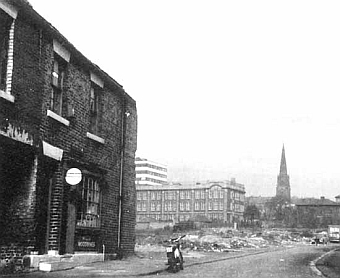 Elswick East Terrace 1967
Elswick East Terrace 1967
This is a close up of the shop at the end of the terrace in the photo above. The bow window dated from 1852 and Henry Stephenson probably shopped here with his grandmother.
John Atlantic Stephenson (1829 - 1914)
Henry's uncle, John Atlantic Stephenson, was a sales representative for a steel company who became well known in the North East as a painter and a song writer. This is one of his pictures :
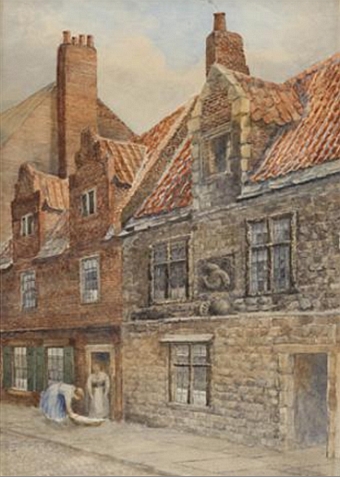 The Dolphin House 1888, John Atlantic Stephenson (1829-1914)
The Dolphin House 1888, John Atlantic Stephenson (1829-1914)
Henry's father
Henry's father, Henry Layton Stephenson, was a railway worker. After his first wife died he married again and started another family. Henry appeared to have lived with his grandmother rather than with the new family. His father emigrated to Ashburton, New Zealand in 1874 with the new family. Henry also emigrated to Ashburton with his siblings in 1878 when he was 18. That was the year his grandmother Elizabeth Stephenson died.
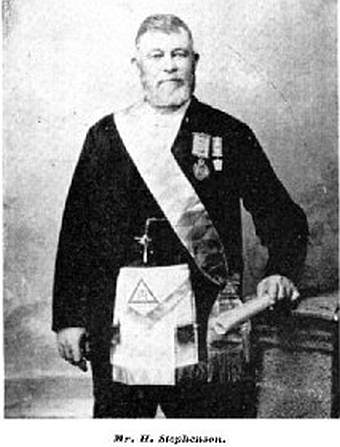 Henry's father - Henry Layton Stephenson
Henry's father - Henry Layton Stephenson
Mr. Henry Stephenson, Driver in charge at Palmerston North, was born in 1834 at Newcastle, England. As cleaner, fireman, and driver, he served some years on the North Eastern Railway, resigning in 1861 to accept the position of locomotive engine-driver on the Great Southern of India Railway (Madras Presidency). For nearly thirteen years he was running the Company's fast service, and otherwise was acting locomotive foreman. In 1874 Mr. Stephenson arrived in Lyttelton, and was appointed engine-driver under the Canterbury Provincial Government, being promoted to the position of driver-in-charge by Mr. A. D. Smith. He has successively been stationed at Ashburton for thirteen years, at Timaru for five years, at Napier twelve months, and at Palmerston North since 1891. Mr. Stephenson is a prominent member of the Masonic brotherhood, having been initiated in 1864 in Emulation Lodge, Neagapatam, India. In New Zealand he was one of the founders of the Somerset—now Ashburton—Lodge, becoming the second W.M. Having passed through the various chairs of the order, he holds office as a member of the Supreme Grand Royal Arch Chapter of Scotland, and is a Past Z. of the same. He is also an Excellent Master S.C., and a Mark Master E.C. In Palmerston North, Mr. Stephenson was one of the founders, and is one of the principals of the Manawatu Kilwinning Royal Arch Chapter. He is also a member and Past Officer of the District Grand Lodge of Canterbury, E.C. In 1854 the subject of this notice was first married, his wife dying in 1862, leaving two sons and a daughter; five years later he was married to Miss Sheaham, by whom he has two daughters.
Quoted from The Cyclopedia of New Zealand 1897
Freemasons
Some years ago I was standing at a charity bookstall outside Allders in Croydon when an Irishman next to me asked the bookseller if he had any books on Freemasons. The Irishman added "I like reading about Freemasons, because I hate them". I exchanged a quick glance and a smile with the bookseller. We both knew we'd got "a funny one" here. There's something about the Freemasons that makes people irrational.
When I looked at the old Ashburton papers I was surprised how open they were about who was Freemason. There were no signs of the secret membership and the dastardly plots we read about today. As far as I can work out Freemasons are just middled aged or older men who like to spend some time with men like themselves. The fact that Freemasons agree to help each other is seen as a wicked thing. I'm not a Freemason but as long as you don't break the law I don't think there is anything wrong with helping others.
"Society wife is disbelieved"
In 1930 Henry's granddaughter Olga Raema Raphael was involved in a divorce case that made the national papers in New Zealand. "Staggering Allegations of Cruelty" was one of the more lurid article headings. According to Olga her husband, Harley Birdling, a member of a prominent Christchurch family, had poor hygiene and rarely washed. He also strangled her, threatened to shoot her and covered her face in sheep's blood. I don't know if Kiwis, even wealthy ones, are noted for being particularly well scrubbed but the judge seemed to find Olga's claim about her husband's hygiene hardest to believe :
NZ Truth 27 November 1930
On cross-examination she said that to get the respondent to wash "you had to drive him to the sink. He said he was naturally clean and only wanted a bath once a month. He was filthy in his habits - he would never wash - filthy hands, dirt on his face and dirty neck..."
She gives the picture of a man lost to all sense of decency and self-respect. In my opinion it would be unsafe to place reliance upon her evidence.
Olga later got her divorce and married George Moon in 1933. She died in 1963 aged 55. Her mother Augusta Gordon Raphael, Henry's daughter, died in 1974 aged 88.
The Savage Club
The Ashburton Savage Club is still going. I don't know exactly what is all about but I imagine it is to do with people taking turns to entertain each other. Nowadays entertainment, like nearly everything else, is globalised. The Savage Clubs are struggling. Why would you want to watch your neighbour do a magic act or sing a folk song when you can switch on your computer or TV and watch the best acts in the world? The answer is that the Savage Club is mainly there for the performer and not the audience. If you are good at something then you probably like to demonstrate your skills. Unfortunately, most people today are just passive viewers of entertainment. We haven't got any skills to show off.
